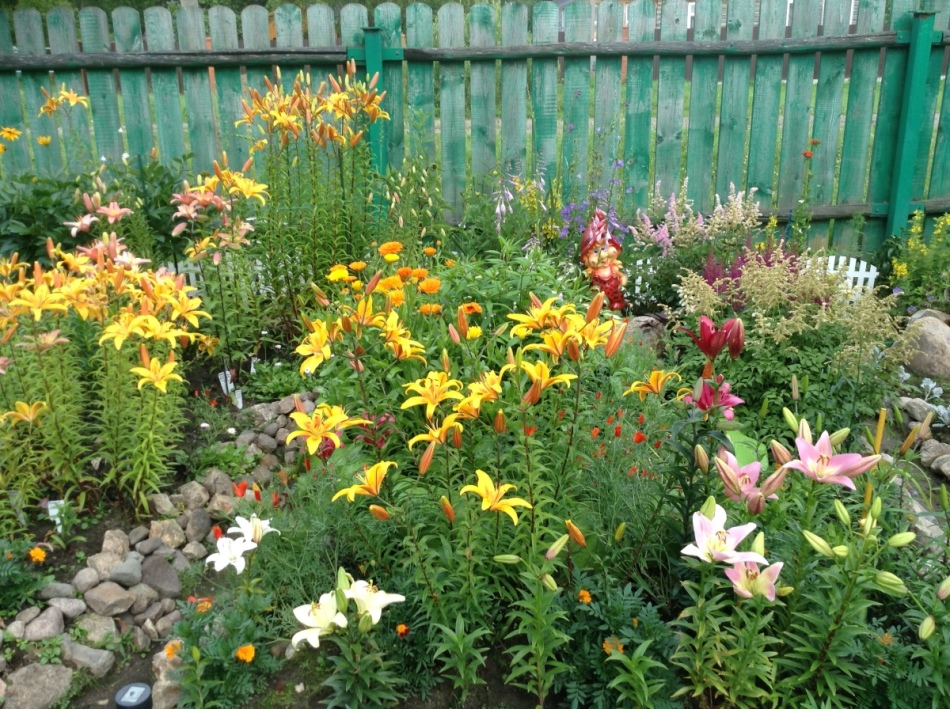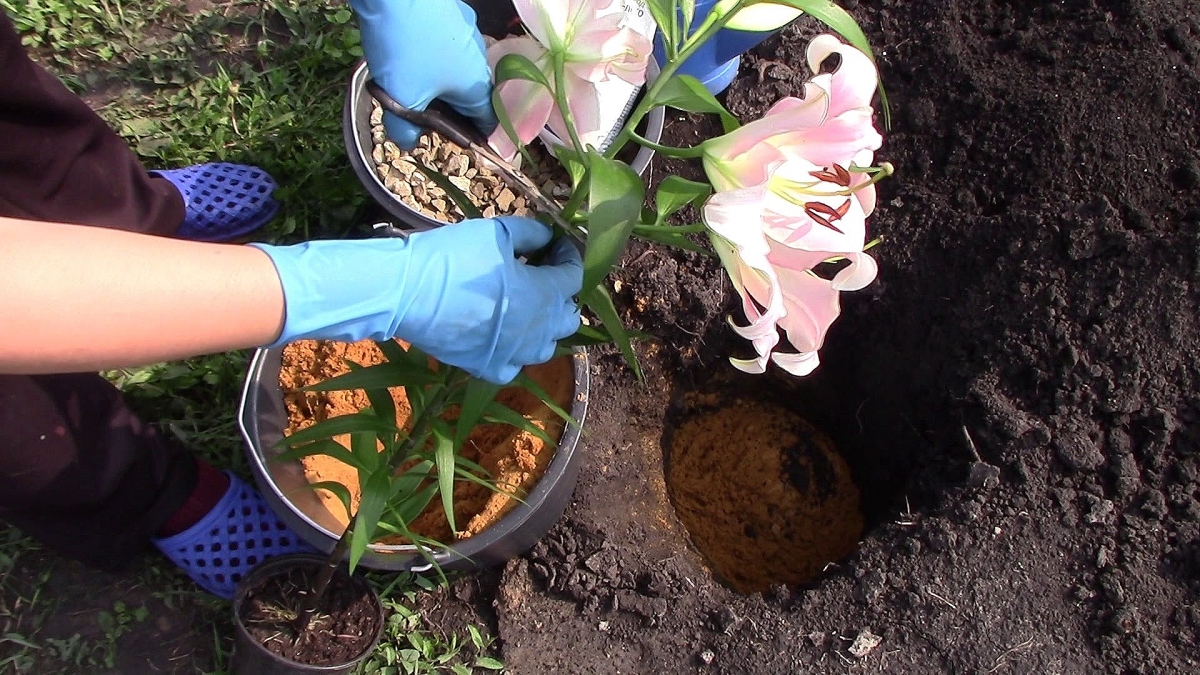Content:
The development of the lily, as well as its ability to give a lush inflorescence, directly depends on how high-quality the nutrition of the bulb will be. It is very important to provide the flower with the correct feeding at different periods of its life. Therefore, before starting to grow these plants, you should study well the question of how to fertilize lilies, as well as when it should be done.
general information
Flowers need regular support at different times of the year. These plants are fertilized in spring, summer and fall.
- The first stage of feeding begins in the spring. After hibernation, the lily wakes up and gathers all its strength to recover, throw away large foliage, as well as lush flowers. Therefore, feeding the lilies before flowering gives the bulb the opportunity at this moment to absorb as many nutrients as possible. And often they are sorely lacking in the soil, which is why they resort to soil fertilization. During this period, it is necessary to feed the lilies with nitrogen fertilizers. It is the nitrogen-containing substances that will help the flowers quickly come into shape and gain leaf mass. For fertilizing lilies, urea or ammonium nitrate (30-35 grams per 1 m²) is suitable.
- The next stage at which the flowers need to be fertilized is the budding period. The plant needs strength to produce healthy and beautiful flowers. Therefore, at this time, he needs to be saturated with nitrogen and phosphorus as much as possible, which will help the growth of buds and give brightness to the foliage.
- Fertilization for lilies in summer is also necessary. In July, flowers are mesmerizing with their beauty and they need help to maintain it. Therefore, you definitely need to know how to feed lilies for abundant flowering. In summer, the plant is fertilized, but not as abundantly as in the spring.
- And finally, the last dressing, which is carried out in September, is needed for the bulb. She must accumulate a lot of nutrients in order to get stronger and survive the winter well.
Further, the questions of feeding and fertilization will be considered in more detail.
How to feed lilies during budding
In summer, fertilizer begins to be applied from the moment the first buds appear. So how and with what to feed lilies during budding?
In order for a plant to form a lush flowering, it is necessary to correctly select fertilizers.
- As mentioned above, phosphorus-nitrogen dressings will be very useful at the budding stage. Therefore, you can add ammonium nitrate. It is brought in at the rate of 1 spoon per 1 sq. meter. In the absence of ammonium nitrate, use a nitroammophos.
- From organic fertilizers, fermented mullein solution will be useful for flowers, which is diluted with water in a ratio of 1:10.
You should also treat the vegetative parts of the flower with anti-pest drugs. Otherwise, insects such as the red beetle, onion leaf beetle and aphids will definitely want to feast on them.
How to water lilies outdoors
Another important question that interests many flower growers is how often to water lilies?
In the wild, these flowers grow in places where foliage covers the soil, which prevents moisture from evaporating quickly. Therefore, lilies are accustomed to water and belong to moisture-loving plants. Hence, these flowers need regular watering. However, care must be taken to avoid stagnant water, as excessive moisture will also not benefit the plant. A flower bulb may begin to rot. The risks of botrytis and fungal diseases are also increasing.
But you should not be afraid - everything will definitely work out if you adhere to the following watering rules:
- In the absence of rain, lilies should be watered about 1 time per week. It all depends on the type of soil: sandy loam is irrigated more often, and clayey - less often.
- Water is poured into the flower only at the root.
- A suitable time of day is the first half of the day, namely before 13:00. This is necessary so that the top layer has time to dry out before night when it gets colder.
- With watering, you should be especially careful in the spring, since frosts can return at this time, and cold nights are also dangerous.
- Spring watering is carried out in conjunction with growth stimulants and anti-stress drugs.
- Most of all, lilies need watering from June to August - in the hottest months, as well as after flowering, when bulbs are forming and the plant needs to stock up on nutrients before winter comes.
Watering is stopped in the fall, when the lilies have faded and preparations for the winter period begin. Of course, if we are not talking about a hot climate, when the soil is very dry. In such conditions, the flower can be watered 2 more times until the leaves finally turn yellow.
How to fertilize flowering lilies
It has its own characteristics and feeding of lilies during flowering. During this period, the flowers need to be fertilized only with liquid agents, since the granules will not have time to dissolve and the plant will not receive the required amount of nutrients.
Blooming lilies must be fed with a double superphosphate substrate and potassium magnesium. Such substances will help to strengthen the stem and give a bright color. This is especially useful for lilies in red and pink.
One of the cheapest options for feeding lilies is regular bread. At the same time, it is not at all scary, if it even became covered with mold, or turned into a biscuit. Fermented bread fertilizer is very beneficial for flowers. This remedy promotes active growth of lilies.
The recipe for this kind of feeding is very simple:
- It is necessary to cut the bread into small pieces and cover them with water.
- For more effect, chopped nettle or dandelions can be added to the mixture.
- The resulting mixture is put under oppression in a warm place, protected from the sun and wind. It should only be taken into account that the fermentation process will be accompanied by a very unpleasant odor. Therefore, it is wiser to put such a mixture somewhere in a secluded place so that it does not interfere.
- The resulting consistency is diluted with water in a ratio of 1:10.
Fermented bread can be used to fertilize plants both during flowering and in spring. At the same time, 2 times a year, the use of such a consistency will be quite sufficient.
Tips and tricks from experienced florists and gardeners
Although lilies are not so demanding plants, still experienced gardeners, observing them, have come to some conclusions and are ready to share their secrets. So, in order for the feeding processes to be successful, you must adhere to the following rules:
- It is recommended to apply spring fertilizer not earlier than the soil warms up to + 6 ° С. Since the climate in the regions is completely different, the land in each region warms up differently.Therefore, some can apply fertilizer in April, while others - in May.
- The most important signal that a lily is already in need of feeding is the height of the stem. If it reaches 10 cm, then fertilization can be started. Previously, there was simply no point in feeding the plant, since the bulb would not yet be able to absorb nutrients.
- In the case when flowers have not grown on the site for many years and the soil is still sufficiently rich in humus, the soil will not need fertilizers for another 3 years.
- If the lily is first year of life, then when it throws out the buds, it is better to cut them off. Without them, the plant will gain more strength, and its bulb will get stronger.
- Lilies do not like a high concentration of fertilizers, so they are fed in small doses in several visits.
- There is no need to fertilize the plant with fresh manure, since, firstly, it burns the flower, and secondly, it contains dangerous microorganisms that can cause diseases.
- A useful fertilizer for plants will be ammonia, which will provide lilies with nitrogen and improve their growth. To do this, you must use 1 tsp. per liter of water. Also, with the help of ammonia, you can fight aphids. But the dosage in this case will be different. You need to take 50 ml and dilute in a bucket of water.
- If there is too much acidity on the site, it should be definitely reduced, since lilies do not like this. Therefore, once every 5 years in the ground for 1 sq. meter add 3 kg of slaked lime or wood ash.
In order for the plants to give violent flowering and a wonderful aroma, you need to make a little effort to care for them, study the information on how to feed lilies and apply this knowledge in practice. After all, these flowers need regular watering and systematic fertilization. It is worth adhering to the recommendations of experienced gardeners, and everything will work out.














